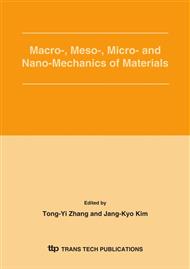p.51
p.59
p.69
p.79
p.87
p.93
p.101
p.109
p.117
Dynamic Strength of Steel Welds under High Strain Rate Loading
Abstract:
An experimental study was conducted to investigate the dynamic strength of steel welds under high strain rate loadings. Flow stresses of both the base steel material and the weld filament were obtained under strain rate loadings of up to 9 × 102 s-1. The data was then fitted to the Cowper-Simmons [1] relation with the D and q values given. The finding helps to understand the strain rate sensitivity of the base and welded materials.
Info:
Periodical:
Pages:
87-92
Citation:
Online since:
September 2005
Authors:
Price:
Сopyright:
© 2005 Trans Tech Publications Ltd. All Rights Reserved
Share:
Citation:


